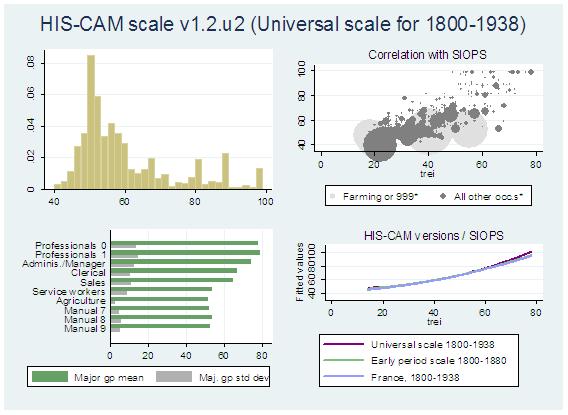Update: 2 November 2013 - v1.3.1 HISCAM scales released (minor update with bug fix from v1.3)
Summary:
This page contains links for a project called 'HISCAM', which stands for 'historical CAMSIS'. We are concerned with using historical data resources obtained from marriage registers, family histories and census datasets, in order to analyse inter-generational patterns of occupational social associations, to derive CAMSIS scales for historical occupatonal records, using the HISCO occupational coding scheme.
The HISCAM project is an undertaking to estimate a series of alternative CAMSIS scales for HISCO coded occupational data. We use data from 7 countries covering the period 1800-1938: the Netherlands; Britain; Germany; France; Sweden; Canada; Belgium (we have also tried some estimations using data from the USA, but have not yet been able to achieve satisfactory results). We use the same scale estimation techniques as for the contemporary versions of the CAMSIS project. The main intention is to generate occupation-based stratification measures suitable to these countries and time periods. This can be done in a few different ways, which include evaluations of the differences between occupational locations from different countries and time periods.
We summarise the HISCAM project in our 2013 article in Historical Methods.
This page is primarily used to distribute selected data files associated with the project. Some article format references on HIS-CAM are described here. Other outputs associated with our work are also distributed via the HISCO project webpages.
Download our scales!
HISCAM VERSION 1.3.1 (NOVEMBER 2013)
Universal scales (derived from data from multiple countries)
U1: Male and female,1800-1938
National scales (derived from data for a single country, males only, 1800-1938)
* The scales for Germany and Sweden are based on relatively small samples and may be less reliable. For these countries, using the universal scale may be preferable. Combined file (all versions)
Citation note:
If you use HISCAM, please take care to clarify the version of the scale that you used, and please can we ask you to cite one of the relevant articles on the scale (at time of writing, our 2013 article in Historical Methods is probably the most appropirate)
We recommend that when you use a HISCAM scale you should refer to its version number and type. We suggest using the scale labels indicated above in combination with the version number. Some good examples might be "Figure 16 uses the HIS-CAM scale (version 1.3.1.U1)" and "correlations using HIS-CAM for Canada (version 1.3.1.CA, accessed December 2013 from http://www.camsis.stir.ac.uk/hiscam/)".
If you're a Stata user, you can open the Stata or .dat files directly from this site, e.g. use http://www.camsis.stir.ac.uk/hiscam/v1_3_1/hiscam_nl.dta, clear
If you're not a Stata user but want to access one of the Stata format files, consider using 'get stata file' in SPSS, or read.dta under library(foreign) in R.
Finally, on terminology, in the recent past we have sometimes referred to our project as 'HISCAM' and sometimes as 'HIS-CAM'. On balance we prefer 'HISCAM', but we won't hold it against you if you use the hyphenated version!
Version history:
v0.1 published May 2006 (http://www.camsis.stir.ac.uk/hiscam/v01/) v0.2 published Feb 2008 (http://www.camsis.stir.ac.uk/hiscam/v02/) v1.0 published Sep 2009 (http://www.camsis.stir.ac.uk/hiscam/v1_0/)
v1.1 published Oct 2009 (http://www.camsis.stir.ac.uk/hiscam/v1_1) v1.2 published Nov 2010 (http://www.camsis.stir.ac.uk/hiscam/v1_2) v1.3 published Feb 2011 (http://www.camsis.stir.ac.uk/hiscam/v1_3) v1.3.1 published Nov 2013 (minor bug fix to v1.3, removing up to 14 erroneous HISCO codes, no change to all other scores) (http://www.camsis.stir.ac.uk/hiscam/v1_3_1)
Recommended cited references for HISCAM:
Lambert, P. S., Zijdeman, R. L., Maas, I., van Leeuwen, M. H. D., & Prandy, K. (2013). The construction of HISCAM: A stratification scale based on social interactions for historical research. Historical Methods, 46(2), 77-89. DOI:10.1080/01615440.2012.715569
Zijdeman, R.L. and Lambert, P.S. (2010) "Measuring social structure in the past: A comparison of historical class schemes and occupational stratification scales on Dutch 19th and early 20th century data". Belgian Review of Contemporary History, 40(1), 1111-1141.
Lambert, P.S., Zijdeman, R.L., Maas, I., Prandy, K., and van Leeuwen, M.H.D. (2008) "HIS-CAM - Presentation and evaluation of an historical occupational stratificaton scale based upon the analysis of social interaction." Paper presented to the European Social Science History conference, Lisbon, 26 February - 1 March 2008 . (presentation slides [powerpoint] [pdf]).
Lambert, P.S., Zijdeman, R.L., Maas, I., Prandy, K., and van Leeuwen, M.H.D. (2006) "Testing the universality of historical occupational stratification structures across time and space." Paper presented to the ISA RC 28 Social Stratification and Mobility spring meeting, Nijmegen, 11-14th May 2006. (Download this paper: draft version of 5th May 2006 [pdf]; presentation slides [powerpoint] ).
Maas, I., Lambert, P.S., Zijdeman, R.L., Prandy, K. and van Leeuwen, M.H.D. (2006) “HIS-CAM - The derivation then implementation of an historical occupational stratification scale.” Paper presented to the Sixth European Social Science History Conference, RAI, Amsterdam, 22-25 March 2006
Comments and questions:
